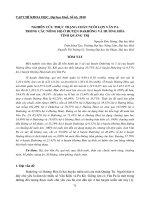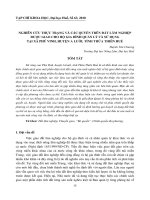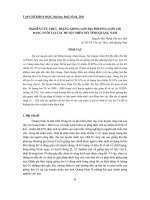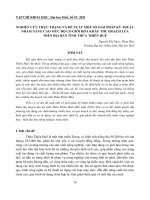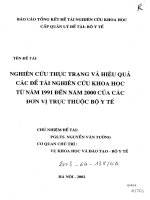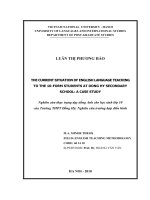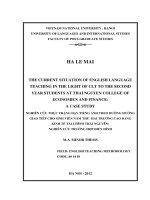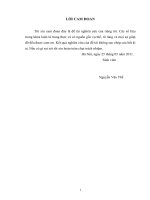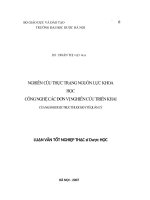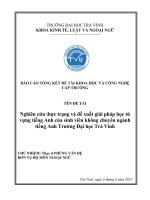Nghiên cứu thực trạng và đề xuất giải pháp cho việc đánh giá kỹ năng nói của học sinh trường PTTH chuyên Nguyễn Tất Thành
Bạn đang xem bản rút gọn của tài liệu. Xem và tải ngay bản đầy đủ của tài liệu tại đây (807.71 KB, 73 trang )
VIETNAM NATIONAL UNIVERSITY, HANOI
UNIVERSITY OF LANGUAGES AND INTERNATIONAL STUDIES
FACULTY OF POST-GRADUATE STUDIES
TRẦN THỊ PHƯƠNG CHI
TOWARDS DESIGNING A TRANSLATION SYLLABUS
FOR THIRD-YEAR ENGLISH MAJORS
AT HANOI UNIVESITY OF BUSINESS AND
TECHNOLOGY
(Xây dựng chương trình dạy học môn dịch cho sinh viên
hệ cử nhân chuyên tiếng Anh năm thứ 3 tại
Trường ĐH Kinh doanh và Công nghệ Hà Nội)
M.A MINOR PROGRAMME THESIS
FIELD : English Teaching Methodology
CODE : 60.14.10
HA NOI – 2010
VIETNAM NATIONAL UNIVERSITY, HANOI
UNIVERSITY OF LANGUAGES AND INTERNATIONAL STUDIES
FACULTY OF POST-GRADUATE STUDIES
TRẦN THỊ PHƯƠNG CHI
TOWARDS DESIGNING A TRANSLATION SYLLABUS
FOR THIRD-YEAR ENGLISH MAJORS
AT HANOI UNIVESITY OF BUSINESS AND
TECHNOLOGY
(Xây dựng chương trình dạy học môn dịch cho sinh viên
hệ cử nhân chuyên ngành tiếng Anh năm thứ 3 tại
Trường ĐH Kinh doanh và Công nghệ Hà Nội)
M.A MINOR PROGRAMME THESIS
FIELD : English Teaching Methodology
CODE : 60.14.10
Supervisor: Đỗ Minh Hoàng, M.A
HA NOI – 2010
iv
LIST OF ABBREVIATIONS
FLT Foreign Language Teaching
HUBT Hanoi University of Business and Technology
SL Source Language
ST Source Text
TBLT Task-Based Language Teaching
TL Target Language
TT Target Text
v
APPENDICES
Appendix 1………………………………………………… i
Appendix 2………………………………………………… v
Appendix 3………………………………………………… v
Appendix 4………………………………………………… iii
Appendix 5………………………………………………….vi
Appendix 6………………………………………………… x
Appendix 7………………………………………………… xi
Appendix 8………………………………………………… xiv
Appendix 9………………………………………………… xviii
Appendix 10………………………………………………… xix
TABLE OF CONTENTS
CANDIDATE‟S STATEMENT i
ACKNOWLEDGEMENTS ii
ABSTRACT iii
LIST OF ABBREVIATIONS iv
APPENDICES ……………………………………………………………………………………………… v
PART A: INTRODUCTION 1
1. Rationale 1
2. Aim of the study 2
3. Research questions 2
4. Scope of the study 2
5. Significance of the study 2
6. Content of the study 3
PART B: DEVELOPMENT 4
Chapter 1: Literature Review 4
1.1. Syllabus in language teaching 4
1.1.1. Definition 4
1.1.2. Types of syllabuses 5
1.2. Translation 7
1.2.1. Definition of translation 7
1.2.2. Translation in teaching 8
1.2.2.1. Grammar-based syllabus 8
1.2.2.2. Task-based syllabus (Constructivism) 9
1.2.2.3. Topic-based syllabus 9
1.2.2.4. Text-based syllabus 10
1.2.2.5. Combined syllabus 10
1.2.2.6. Skills 11
1.2.2.7. Directionality 12
1.2.3. Types of translation in translation pedagogy 14
1.2.4. What is happening in other universities 14
1.2.4.1. General situation 14
1.2.4.2. Examples 15
1.2.4.3. Summary 19
1.3. Needs analysis 20
Chapter 2: Methodology 21
2.1. Data collection instruments 21
2.1.1. Structure of the questionnaire 21
2.1.2. Structure of Interviews with the teachers 22
2.2. Subjects of the study 22
2.3. Data collection procedures 22
2.3.1. Questionnaire 22
2.3.2 Interviews with the teachers 23
Chapter 3: Results and Discussion 24
3.1. Questionnaire 24
3.1.1. Learners‟ background 24
3.1.2. Target needs 24
3.1.3. Learning needs 28
3.2. Interviews 31
3.2.1. The teachers‟ background 31
3.2.2. The teachers‟ comments 31
3.2.3. Suggestions 32
3.3. Summary 32
Chapter 4: The proposed translation syllabus 34
4.1. Introduction 34
4.2. The aims and objectives of the translation course. 34
4.3. Choosing the translation content 35
4.3.1. The integration of translation theory 35
4.3.1.1. Introduction to History of translation 35
4.3.1.2. Introduction to Translation 36
4.3.1.3. Translation Methods 36
4.3.1.4. Text analysis 36
4.3.2. Grading content 37
4.4. Tasks and activities in the year 37
4.5. A proposed translation syllabus for third-year English majors at Hanoi University of
Business and Technology 38
4.6. Sample translation lesson (Appendix 8) 42
Part C: CONCLUSION 43
1. Summary 43
2. Recommendations for further research 44
References 45
1
PART A: INTRODUCTION
1. Rationale
It is without doubt the economic changes all around the world have honestly affected the
language translation service and these days translators are equally involved in every part of
intercultural and business communication. In a world globalization, today language translation
service is becoming a more significant factor for concise transfer of ideas. Translation has
previously been regarded as an art or a craft; now translation scholars are happy to have their
activity recognized as a science and admitted to the inner circle of scholarly pursuits as a
branch of applied linguistics.
Educating English majors to fluently use the foreign language after an undergraduate course is
a becoming an ever important task now in Vietnam when we integrate more deeply into the
world‟s economy. One of the jobs graduates can do is to work as translators or interpreters in a
professional manner. How can educational institutions make sure that their graduates can
adapt themselves to the market changes? Therefore, gaining an insight into target needs and
learning needs so as to develop a translation syllabus is an urgent task. I myself, as the
researcher, would like to try to build up a translation syllabus which is helpful for teachers and
meets with the desires of the learners.
In the process of teaching translation the students, it seems that our current syllabus does not
quite meet the learners‟ needs and what the instructors want them to learn during the course.
There are different opinions among the teachers about the content of the course. At least the
syllabus should give teachers and learners a direction of what to be taught and how to be
taught. Both the teachers and students have complained about the time available for the
learning of skills in the first and second years. This is the time when acquisition of English
skills is so important to be used as the foundation for the third year when more time is spent
on translation practice.
As for the students, they are not proficient in the 4 skills after the first two years. This has led
to the fact that they meet some difficulties in learning translation and interpreting. Besides, it
2
seems that theoretical backgrounds as well as the methodology have not been paid much
attention to.
Another point is that the researcher sees that little time is spent on teaching students
translation-related skills such as the use of computers as a tool for would-be translators and
interpreters. Ulrych (2005) in her paper asserts that technological aids improve translators‟
status and self image.
2. Aim of the study
The study is aimed to identify the needs, wants and lacks of the third-year English majors and
expectation of trainers or course designers so that the researcher can use them as the
foundation for putting forward an appropriate syllabus including content, method of teaching,
time. To achieve the aim, a needs analysis was done to find out the target needs and learning
needs of the students.
3. Research questions
1. What are the learning needs of the third-year English majors?
2. What are the target needs of the third-year English majors?
3. How should the proposed syllabus meet these needs?
4. Scope of the study
The study is done based on the circumstance for third-year English majors at Hanoi University
of Business and Technology (HUBT). Due to the size of the thesis, this is aimed at designing a
written translation syllabus for them (an oral translation syllabus is therefore not within the
scope of this thesis).
5. Significance of the study
This is aimed at making learning of translation more efficient in terms of learners‟ desires,
trainers‟ objectives based on the learning needs and target needs. Theoretically, this will help
provide teachers with basic knowledge of syllabus design in general and translation syllabus
design in particular. Hopefully, this syllabus will give teachers as well as students the profile
of what and how should be taught and learnt in order to achieve the course‟s objectives.
3
6. Content of the study
Part A: Introduction is aimed at providing the background, rationale, the aims, research
questions and significance of the study.
Part B: Development
Chapter 1 Literature Review reviews the literature of syllabus design, translation teaching
and translation syllabus.
The first part is about syllabus design and types of syllabi which are used as a base for
designing the proposed syllabus. The second part taps into translation in terms of definition,
types of translation syllabi, types of translation and the training situations in some European
and Asian countries. From the situation, the researcher may apply some good ways in
designing the proposed syllabus.
The last part will provide some facts about The English Department, Hanoi University of
Business and Technology.
Chapter 2: Methodology deals with methodologies of collecting data.
Chapter 3: Results and Discussion consists of an analysis of a post-course questionnaire, a
semi-structured interview with the translation teachers.
Chapter 4: The Proposed Translation Syllabus is devoted to the proposed translation
syllabus including the aims, objectives of the translation course, the translation content, tasks
and activities, the proposed syllabus and a sample translation lesson.
Part C: Conclusion and Recommendations
This chapter summarizes what has been done and arrive at recommendations for further
research.
4
PART B: DEVELOPMENT
Chapter 1: Literature Review
1.1. Syllabus in language teaching
1.1.1. Definition
A syllabus can also be seen as a "summary of the content to which learners will be exposed"
(Yalden 1987: 87). By looking at the syllabus, learners can know where they are during the
course, and what they will have achieved. Therefore, the syllabus is actually a very basic guide
for them. Hutchinson and Waters (1987: 80) define syllabus as follows:
At its simplest level a syllabus can be described as a statement of what is to be learnt.
It reflects of language and linguistic performance.
There is another view further with the aim of a syllabus. Breen (cited in Read 1984a: 1) asserts
that syllabus can also be seen as "a plan of what is to be achieved through our teaching and our
students' learning". I quite agree to this approach as teachers often base themselves on a
certain syllabus to make their lectures detailed. In Wilkins' (1981: 1) words, syllabuses are
"specifications of the content of language teaching which have been submitted to some degree
of structuring or ordering with the aim of making teaching and learning a more effective
process.” If the above authors focus on the content factor in the process of syllabus design,
some other authors tend to have a quite different point of view. Candlin (cited in Nunan 1988:
46) wondered whether it is possible to distinguish the content from the method and evaluation.
The researcher thinks that it is better to combine all these factors to have a more
comprehensive view to what teachers are to do in class. Breen (cited in Nunan 1988: 46) also
has the same viewpoint which does not only mention the pedagogy in the syllabus but also
certain assumptions about the psychological and social processes. From my own teaching
experience, syllabuses in Vietnam only reflect the pedagogy but not the others mentioned by
Breen as they require experts with rich knowledge of psychology and social issues.
Dublin and Olshtain (1986: 28) offer a very comprehensive view on syllabus. They hold that it
should contain the following ingredients:
1. What the learners are expected to know at the end of the course, or the course objectives.
5
2. What is to be taught or learnt during the course.
3. When it is to be taught, and at what of progress relating to the inventory of items to the
different levels and stages as well as to the time constraints of the course.
4. How it is taught, suggesting procedures, techniques and materials.
5. How it is to be evaluated, suggesting testing and evaluating mechanism.
In the process of designing the translation syllabus for HUBT students, the researcher would
like to adopt the comprehensive view as such a syllabus specifies not only what to teach but
how to teach as well. Such a syllabus may contain some items such as aims of the course of
study, expected outcomes, names of major topics and activities/tasks, time allocation,
suggested teaching/learning methods and materials.
1.1.2. Types of syllabuses
Designing English as Foreign Language (EFL) syllabuses is increasingly important in
language teaching as it reflects the direction of the whole program in terms of course
objectives, content, methodology, assessment, and attendance. This subject has attracted a lot
of attention from linguists. Therefore, there have been various opinions on types of syllabuses
so far. In this section, the author of the study would like to present several types of syllabuses
with their specific features.
1.1.2.1. Structural (grammatical / linguistic) syllabus
As Dublin (1986: 37) asserts, the structural (grammatical / linguistic) syllabus focuses on
grammatical elements. Structural syllabuses are the ones in which the content of language
teaching is a collection of forms and grammatical structures of the language being taught,
„sequence from easy to difficult or frequent to less frequent‟ (Brown 1995: 7).
1.1.2.2. Task-based syllabus
Nunan (2001) defines task-based syllabus as representing “a particular realization of
communicative language teaching. Instead of beginning the design process with lists of
grammatical, functional-notional, and other items, the designer conducts a needs analysis
which yields a list of the target tasks that the targeted learners will need to carry out in the
6
„real-world‟ outside the classroom.” In my reflection, this type of syllabus is suitable for
students who are learning business English for their future jobs.
Task-based syllabuses enhance learning. They are different from other types of syllabuses in
that learners can acquire some skills as a result. Thus, they are not based on linguistic forms
but the division of tasks and activities done in the class (Read 1984: 42). Richards (2001: 161)
further clarifies that “these syllabus tasks and activities are basic units” of a syllabus. I think
this approach is preferred now as our teaching pedagogy is so practical that we should provide
learners with skills which they can use at work well especially this type of syllabus is suitable
for a translation class where acquiring skills is an important part.” By providing such tasks and
activities (which are of course based on the overall aims of courses) in class, learners can be
actively engaged in class and acquire the home language and skills easily.
1.1.2.3. Topical syllabus
Topical syllabuses are organized around themes, topics rather situations (Brown 1995: 9).
With a topical syllabus, content is the starting point in syllabus design. Topics are selected by
the syllabus author on the basis of his/her sense of importance of the topics or themes to the
lives of the students. The main advantages of this syllabus type are mentioned by Robinson
(1991: 37) and Richard (2001: 158) as follows: it can address learners‟ needs and can motivate
them. It can allow for the use of authentic materials and can act as the best basis for the „real
syllabus‟ of language forms, functions or whatever the syllabus designer wants to focus on.
1.1.2.4. Skill-based syllabus
Another one is the skill-based syllabus. This kind of syllabus organizes materials in terms of
the language or academic skills which the students will most need in order to use and continue
to learn the language. It just focuses on the four skills in learning English. For instance, a
reading course might include such skills as skimming a reading for the general idea, scanning
a reading for specific information. The selection of the skills comes from the author‟s
perception of their usefulness, whilst their order is normally based on some sense of
chronology, frequency, or relative usefulness of the skills (Brown 1995: 11).
7
1.1.2.5. Mixed or layered syllabus
There is a tendency that syllabus designers combine two certain syllabus types or more. This
makes the family of syllabi adopt a new member called mixed syllabus. Discussing this new
type of syllabus, Brown (1995: 12) states, „mixed syllabi occur when authors choose to mix
two or more types of syllabi together into what looks like a different type of syllabus – at least
in the table of content.‟ Then depending on priorities on a certain course, course designers can
combine one type of syllabus with one or two others to bring about a suitable syllabus
framework for the course.
1.2. Translation
1.2.1. Definition of translation
For the benefit of the readers, some clarification should be made to the concept of translation.
Reiss and Vermeer (1984) assert that translation and interpreting are considered as one. Both
activities are about that a source text should be translated into a target language (TL) one. The
following definition covers both translation and interpreting:
It is a written or spoken expression of the meaning of a word, speech, book, etc. in
another language.
(The Concise Oxford English Dictionary, 11
th
edition, revised 2008)
However, in the framework of this study, the researcher would like to use translation to refer
to the written form of transferring ideas from one language to another.
Translation consists of reproducing in the receptor language the closest natural equivalent of
the source language ( SL) message, first in terms of meaning and secondly in terms of style
(Nida & Taber 1974:12, cited in Hoang 2006). Catford (1965) has a similar view but in terms
of textual material when claiming translation is the substitution of textual material in one
language (source language) by corresponding textual material in another language (TL). We
can also see another way of definition: Translation is the replacement of representation of a
text in one language by a representation of another equivalent text in a second language
(Hartmann & Stork 1972: 713). Bell (1991) has another view when indicating translation is
8
the expression in one language (or TL) of what has been expressed in another (SL), preserving
semantic and stylistic equivalences. He thinks translating is the transformation of a text
originally in one language into an equivalent text in a different language retaining, as far as
possible, the content of the message and the formal features and the roles of the original text).
To be more specific, Wiles (1982: 112, cited in Hoang 2006) claims translation is a procedure
which leads from a written SL text to an optimally equivalent TL text in terms of syntactic,
semantic, stylistic and text pragmatic comprehension by the translator of the original text.
There are some approaches to translation as a process. Translation, as the process of
conveying messages across linguistic and cultural barriers, is an eminently communicative
activity, one whose use could well be considered in a wider range of activities than may
currently be the case (Tudor, cited in Duff 1989: 5). Hatim & Mason (1990: 3) shares the same
view when claiming translating is a communicative process which takes place within a social
context. In my opinion, depending on different situations, the translation (as a product) can be
transferred either to keep the original the same or suitable for the readers. All in all, translation
does the task of moving a text from one language to another.
1.2.2. Translation in teaching
As the researcher doing research on designing a syllabus, it is important to consider some
factors to design an efficient one. To make it clear what should happen during a translation
course especially during the third year, the researcher would like to do research on different
types of translation syllabuses, skills needed by the students, discussed by experts and wonder
if it is a good idea to teach translation in both ways (direct translation-L2 into L1 and reverse
translation L1 into L2).
1.2.2.1. Grammar-based syllabus
Vermeer (1998:60) states that translation teaching and learning have traditionally relied on the
old methods of language teaching. Language learning was a question of acquiring a bottom –
up skill in language reception and production moving from teaching smaller linguistic units to
larger ones. Linguistic theories of translation solve the problem of equivalence by defining it
in terms of textually sufficient similarity of content between SL and TL. The translator‟s task
9
ends with the linguistic production of a target text (TT). Zeng and Lu-Chen (2002) further add
that by using this syllabus, students concentrate on specific linguistic problems without
adhering to the overall picture of translation process. Students may gain individual techniques
but it is challenging to produce a satisfactory target rendition of a larger source text (ST).
1.2.2.2. Task-based syllabus (Constructivism)
There is a very interesting point when applying constructivism to the translation pedagogy. As
a matter of fact, learners should be encouraged to take part in different activities during the
course. This is really important in learning translation. It should be a process rather than a
product. Duffy and Cunningham (1996:171) mention two principles which are “learning is an
active process of construction rather than acquiring knowledge and instruction is a process of
supporting….” Kiraly (1995), the first person applying constructivism in translation pedagogy,
asserts that he wants to give direction to building an educational culture that empowers the
learners. The researcher thinks that only by doing things at first hands and practicing, do
learners acquire skills required by a translator. Task-Based Language teaching (TBLT)
employed real world or pedagogical tasks as units of syllabus design. Long & Crookes (1992)
suppose in the TBLT approach, the teaching process is a simulation of real world experiences.
Pica, Kanagy & Falodun (1993) hold that students learn best through social interactions
enabling them to reach a common goal, by exchanging information and solving the same
problem. Then, students should work together in class, which promotes students‟ motivation
to learn.
1.2.2.3. Topic-based syllabus
This type of syllabus rates translation experiences around fields of knowledge. Example of this
type can be found in Sewell‟s survey (1996: 152): translation material in many universities
“focuses on areas such as education, university life, the media or current affairs.” This
framework has also been very popular in translator training programs in Vietnam. As Richards
observes, topic-based syllabus is believed to address students‟ needs and thus motivate them
(2001: 158). This might be the reason for the popularity of this framework in Vietnam.
10
1.2.2.4. Text-based syllabus
With the development of text linguistics, a “top-down approach” to translation has been
introduced with the overall evaluation of a ST, moving from larger units to smaller units.
Organizing the translation experience around the analysis and experiences of text types has
become a common practice because it is believed to be “closely related to the actual process of
translation, with different types placing different demands on the translator” (Reiss, cited in
Nguyen 2005: 14). The notion of text and text-type has been employed in translation
curriculum design of many universities. According to subject matter, texts can be categorized
as journalistic, technical, and literary and so on. In terms of function, text types include
expressive, informative and vocative (Newmark 1988).
1.2.2.5. Combined syllabus
For the translation syllabus design, we adopt a combination of topic-based, text-based and
task-based syllabus. First, students will choose the topics they would like to translate, then the
teacher, taking target needs and learning needs into consideration, will decide the most
suitable activities. Snell-Hornby (1992:19) states that translation activity should reflect “the
realities of future professional needs”, even in the setting of a training program if it is to be
viewed as an authentic task. Marsh (1987) claims the text types used for translation are
journalistic, literary technical or scientific. He recommends two categories: journalistic and
technical being the most suitable for language learners. Choosing articles from newspapers,
magazines, and journals are appropriate especially for the students at HUBT- a business
school, and this is also in line with what Marsh argues:
They are …. based on the topical issues which the students are likely to have
knowledge of and interests in, therefore increase motivation, and reducing cultural
lacunae; the language is modern; within journalese, style varies considerably
depending on which section of newspapers, magazine or journal ….; information load
is usually high, calling for extremely compact syntactic structures and a high
11
proportion of content lexical items, which proves challenging without being
impossible; and finally, topic range is wide (p.28).
1.2.2.6. Skills
The cooperative model is proposed by Holz-Manttari (cited in Mackenzie 2004: 36). With the
role of future translators in mind, teachers should offer situations in which students can
practice translators‟ roles including product specification (analyzing what type of ST is and
the situation by using the formula suggested by Christiane Nord (1991) which is - who is
saying what to whom, why, how, by what means, for what purpose?- and deciding whether the
TT needs those factors, then the text itself- resource, time and client management skills used)
text research (consultation of the ST‟s author, colleagues and experts on the subject … to
bridge the gap in one‟s “own deficient knowledge”), text production (composition skills-rules
of cohesion, coherence, ability to identify and write indifferent register – as well as text
processing skills are needed), and text evaluation (quality management skills-choosing the
way to translate based on different situations, kind of revision, client management skill to
obtain clients‟ satisfaction). Holz-Manttari (cited in Mackenzie 2004: 36) asserts that “in
translation companies these roles are separate”. However, to prepare student translators for
working life in the translation industry today, it seems reasonable to give them opportunity to
practice all of these roles in the course of their training. He further states that translators need
to have linguistic skills -cultural skills, inter-personal skills, IT skills which are used for
research and text production, assisting the translation process when using translation memory
tools, terminology software and the Internet. He also emphasizes that students should be
immersed in real or simulated situations. Apart from practice in translation skills,
professionals need to have history background, theory and methodology of the subject so as to
get a deeper understanding in their roles and enhance the self-image as professionals.
Ulrych (2005:16) also mentions the use of translation aids. “Computer skills are a basic
requirement of professional translating today since it provides powerful tools for translators to
work competently and reliably in various domains”. Bowker (2002) notes that they help
enhance translators‟ status and self-image. Being able to use new technology represents an
12
added professional skill for translators, and it is a skill that is becoming increasingly
appreciated in the market place. Therefore, as Bowker (2002) asserts, the integration of
technology into a translation program inevitably has an impact on the way translation itself is
taught.
Besides, “translator are not infrequently confronted with defective texts, and they need to be
able to summarize, explain or adapt according to the needs of the employer concerned” (Snell-
Hornby 1992: 20). Research skill is important for translation too. A translator will not be in
touch with only one topic or an area of knowledge. A translator at the start of his/her career
may not have comprehensive knowledge of all fields. Therefore, a good research skill will
enable him/her to adjust to all working situations and thus go further in their work. Once again
Bermardini (2004: 28) claims that “translation skills are the very essence of the translation and
translating professions: They are […] what, first and foremost, we should teach the translators
of tomorrow”.
1.2.2.7. Directionality
There is another issue in designing a syllabus. Should the students be taught direct translation
or inverse translation or both?
Hatim (2001:164) in his book, Teaching and Researching Translation, says this is about
whether translators work from their mother tongue into the foreign language or the other way
round. It is believed that working into one‟s mother tongue (the “A” language) is the natural
order. In fact, teachers and employers tend to think that bilingual competence is important and
that translators should have no difficulties well in both directions (into and out of the foreign
language). The debate on this has a great value to training and pedagogy of translation.
Newmark (1988: 3), while acknowledging the existence and value of what he calls “service
translation”, believes that “translation into the language of habitual use is the only way you
can translate naturally and accurately and with maximum effectiveness”. In most European
translator-training institutions, according to Hatim (2001:164), the general tendency is
translation into the mother tongue as the normal direction. Lonsdale (2000: 64) claims this is
also dominant in English-speaking countries as well as in the practice of professional
organization. Campell (1998: 56) states that when translating from a second language, the
13
problem is to understand the ST. In translating into a second language, comprehension of the
ST is easier; the real difficulty is to make a natural TT.
However, Lonsdale (1998) says in the context when English has become the language of
international trade and communication, the numbers of translations in English far outweighs
those into any others and there are not sufficient translators with English as their mother
tongue at the right place at the right time, many translators are inverse. And Vietnam is not an
exception. As Newmark (1988: 52) states, “the practice [translating from one‟s language of
habitual use into another language] is necessary in most countries.
In Australia, many translators are accredited to work in two directions. There are plenty of
translations in Australia are done into and from English. Therefore, despite of advantages of
translating into their first languages, there will always be the need for many to work into
second language. This is quite true in Vietnam. The need to translate into Vietnamese is great.
The same is true for translating into English literary works, diplomatic documents, and
tourism brochures. Therefore, learners must be taught to translate in both ways: direct and
reverse translation. Technical and scientific translations are also often inverse translations: In
specialized fields, […] it was more suitable to use a subject specialist with knowledge of the
source language than a mother tongue translator especially if the text is subsequently edited”
(Snell and Crampton 1989: 85). The researcher thinks it is important to understand
terminologies to translate in specialized fields.
Dollerup (1996: 26) asserts the importance of accepting a double directionality. Firstly, it
brings the real-life fact that most translators actually have to work in at least 2 directions into
the reality of classroom. Secondly, translators make errors, but they do not make them
deliberately. Single directionality is just suitable for language acquisition. Otherwise, double
directionality brings to light a number of factors in the translation activities which are ignored
in single-directionality classes such as opaqueness of source text and importance of fluency
and style in the target texts.
In summary, the use of teaching double directionality is essential in teaching translation in
that it helps the students produce acceptable translations in ST and TT. More importantly, this
will enable them to be adaptable to the real demand of the translation market. For these
14
reasons, we propose to design a syllabus that develops double directional skills for our
students at HUBT.
1.2.3. Types of translation in translation pedagogy
Sofer (1998: 37) asserts that the translation field is divided into literary and technical
translation. Literary translation covering such areas as poetry, fiction, drama, and the
humanities in general is often done by writers of the same genre or at least by translators with
the required literary aptitude. Technical translation is extremely broad. It covers much more
than technical subjects in the narrow sense of the word. If the text being translated includes
specialized terms in a given field, then it is technical translation. In the context of HUBT,
which is a business school, students are oriented to translate technical translation. To be more
specific, it is better to offer them most materials on the subjects of business, banking and
finance so that the students can utilize their background knowledge in L1 and are actually
motivated to do so. For more types of translation, please refer to Appendix 1. Based on the
context of HUBT, translations will be on topics of finance, business and economic activities.
Therefore, commercial, economic and financial translation will be main topics in the third
year.
1.2.4. What is happening in other universities
1.2.4.1. General situation
Before deciding to design a translation syllabus, the researcher would like to have a review of
what other universities in Europe and Asia are doing. The demand for translators increases
sharply together with the economic development. This is quite true for Vietnam where a lot of
students not trained in translation or interpreting are working as translators and interpreters. In
other countries, a lot of universities have opened T/I courses in response to this demand. Post-
graduate translation programs are also organized to enhance translation skills. Some
institutions provide undergraduates programs specifically designed to train translators, others
offer such training in postgraduate ones. Those that have both undergraduates and
postgraduate programs provide a general degree, leading to a specialist training at a higher
15
level. As for the length o the course, most last 4 years while some others last 3 years. A few
offer a 2-year diploma course. On an average, a course lasts 25 to 35 weeks per academic year
or 12 to 16 weeks per semester. At some institutions, a majority of the time is devoted to
contacts hours. In general, the average distribution is 50%.
1.2.4.2. Examples
The researcher would like to provide some facts about translation training courses in some
countries in Europe and Asia and at the same time try to relate to the situation in her HUBT
through comparisons and learning.
a. Singapore
In Singapore, English-Chinese translation has been part of the programs offered by the
Department of Chinese at the National University of Singapore since the 1960s as an elective
leading to degree in Chinese (a 3-year system). They can continue the fourth year with
specification in translation to take the English-Chinese translation degree. In comparison with
courses in China, the structure of these translation courses in Singapore is more strictly
defined in that there is a clear demarcation between theoretical and practical work, as shown in
the chart (See Appendix 2). Only 2-3 teaching hours are spent on practical work. To enhance
students‟ practical work hours, they are given translation home assignments. The researcher
can see this can be applied more at HUBT. Hung (2002) asserts critically that the fourth year
of optional specification reflects the dilemma of recognizing the need for more intensive
training and not being able to provide truly professional courses. The researcher thinks that it
would be better if students have another compulsory year learning translation in order that
their translation skills are strengthened. In fact, in Singapore, translation remains
overshadowed by other languages and literature courses. This is not seen at HUBT where
training subjects are mostly business-oriented and translation is taught so as to enable the
students to work as professional translators in that context but not in linguistics and literature.
Though the scope is limited, Singapore has clear objectives in training students to be
employed in relevant government departments and the mass media. In comparison to HUBT,
16
we have also set clear targets which will be mentioned in Chapter IV: the Proposed
Translation Syllabus.
b. Hong Kong
Hong Kong is the first among Chinese communities to teach translation as an academic
discipline rather than an element of foreign language acquisition. The first course with
professional orientation was the High Diploma in Translation and Interpretation offered by the
Hong Kong Polytechnique. Unlike the situation in China and Singapore, the course is much
more intensive and career-oriented. When looking at this chart, (See Appendix 3), the
researcher sees that during the second and the third year, no focus is put on translation.
Therefore, translation skills are definitely not enhanced. However, there is one interesting
thing about this course. During the third year, group project is integrated. This will help
students be familiar with team work, which is very popular among professional translators.
Therefore, the researcher does suggest the syllabus for the third year at HUBT should take
this into account as well.There are different types of programs at university level. One
translation program is a four- year course with the third year being a compulsory internship
designed to tackle the problem of the professional gap. Another one offers the only combined
major allowing students cross-departmental as well as cross-faculty options. From the point of
view of the researcher, this way can be applied at HUBT. There are a lot of good students
from other departments such as management, finance and banking, accounting who want to
improve their English or even want to be professional translators at HUBT. Why don‟t we
offer them an opportunity after they finish their second year as long as they pass a requirement
test?
c. Spain
Beeby (2004: 39) makes it clear that translation has been taught as an undergraduate degree
since 1972. The course lasts 4 years. The students learn Chinese as second foreign language as
beginners and only start direct translation in the third year. The teachers are translators with a
university and mainly literature PhD holders who are also part-time translators. This may
cause conflict between what the learners expect and the university. Literature – oriented
17
teachers want to have more linguistics and literature in the curriculum, whereas the more
professionally-oriented students like a more practice and not too much theory.
In their third year, different modalities of specialized translation are introduced, such as
dubbing and subtitling, scientific, legal, commercial, or literary texts. It is at this point that
students start translation from their C language (one of the two foreign languages available to
them) and follow subjects on resourcing for specialized terminology. Also, third-year students
have to decide whether they would like to specialize as translators or interpreters and follow
one pathway or another. This is not always easy and levels may vary since not all faculties
offer the same number of credits in interpreting due to the high cost of the equipment, the
difficulties in finding teachers and the low number of students who choose this pathway. This
is quite true at our HUBT in terms of teaching staff, facilities and the students. Therefore, in
the coming time, it is hard to train the students either in translation or interpreting. Besides, the
students at HUBT has quite similar attitude as those in Spain. Then the teachers should make
the students think that a lot of skills are needed to translate a text.
d. Italy
Bernardini (2004: 24) points out that traditionally, Italian undergraduate courses lasted 4
years, ending with a Masters-like dissertation. Undergraduate translation and interpreting
followed a similar model - the Y model (See Appendix 4): all students learn together in the
first two years, and then the students choose to specialize in either translation or interpreting.
This is the same as in Spain. This may be applied in HUBT on the condition that the student
intake improves in the near future and the teaching staffs are competent enough for each
specialization. The Italian university systems want to change towards undergraduate and
postgraduate courses with closely integrated modules. This has not been done not only at
HUBT but also at other colleges of foreign languages in Vietnam. There are a lot of
preparations to be made in terms of teaching staff, facilities as well as the programs before this
model can applied in Vietnam. Now they, in Italy, offer three-year courses aimed at fostering
the development of the ability towards a goal, and adopting a professionally correct attitude
towards work. Hopefully, this can be fully understood by translators at HUBT so that they are
aware of the needs of continuously reviewing their teaching to catch up with the world‟s most
18
up-to-date translation pedagogies. In Italy, teaching and research skills are taught because they
not only want to train professional translators and interpreters but also interpreting, translators
and language teachers. The research skill at least may be useful at HUBT and should be
integrated in the third-year syllabus in that during this year more texts on specialized topics
are assigned to the students. They need this skill to learn how to store terminology on each
topic which they may use in future.
e. Sweden
According to Dimitrova (2002), the Institution for Interpretation and Translation Studies at
Stockholm University works in close collaboration with language departments and other
universities in Sweden in organizing programs of varying duration in professional
translation and in interpretation. Both interpreter and translator training programs are based
on the students‟ previous knowledge of TL and SL. Training is organized into specialized
programs on a more advanced, although still at the undergraduate level. A special entrance
test ensures students be competent in SL, TL and translating. Teachers are mostly from
university language teachers. The Institute also invites professional translator to ensure a
professional perspective. However, university teachers are too theoretical and professional
translators are too practical and rarely have experience in pedagogy. This situation is
similar to the one in Spain. The following skills are needed in reading and understanding
ST and producing the TT: use of different kinds of aids such as dictionaries, term lists and
term banks, databases, encyclopedia, specialized literature and parallel texts, consultations
with specialists. The students can be given some competence in one or several areas of
specialization. The competence is about revision (Mossop 1992), use of computers. Some
tasks for freelance translators are advertising their own business, managing contacts with
clients and dealing with accounts. The contents of the course include the translation theory
and the didactics of translation. From the way translation courses are conducted in Sweden,
there are 4 things which can be learned and may be employed at HUBT:
* It necessary to cooperate with language departments to teach the students Vietnamese and
translators as well as experienced teachers of translation on designing training programs.
* The program should take students‟ linguistic competence into consideration.
19
* Specialized programs can be considered
* Teachers of translation are encouraged to take part in actual translating or in short courses
for translation pedagogy. As a result, they have good teaching methods and bring to class
the practical world of translating.
1.2.4.3. Summary
In conclusion, after reviewing some translation courses in some countries, the researcher
would like to arrive at some comments regarding the proposed training program. Firstly,
most of training programs last between 3 and 4 years. Secondly, there is a need to combine
theory and practice during the course. In terms of practice, some translation-relating skills
are paid attention to such as use of translation aids. Thirdly, the success of a course depends
a lot on teachers‟ capability, students‟ intake and the program itself. Fourthly, from the
third year, students from other departments can follow a translation course if they are
qualified enough or English majors can choose to specialize in translation or interpreting.
Finally, most countries are moving forwards to professional and career-oriented courses.
Do (2007: 86) suggests that students should be taught general knowledge on translation and
interpreting skills in the initial stage and translation and interpreting skills at later stage for
the two reasons:
+graduates do double directionality
+graduates will work as translators and interpreters
There are good reasons why these models should be localized. In terms of the proficiency
of the learners, the students‟ intake is not so good. Therefore, more time should be spent on
fostering the four skills even in the third year. In teaching translation, understanding the ST
is very important. That is why students in the third year should be good at that reading skill
and given more opportunities to foster it. Besides, HUBT mainly deal with business issues
in its curriculum. Therefore, it is practical to make students specialize in translating
commercial, financial and economic texts. The students „background in business will
motivate them to learn translation. Once again, the teaching of translation should be career
- oriented rather than literature-oriented like in Hong Kong. By that I mean the students
need to deal with translation on economic and business topics, have opportunities to
